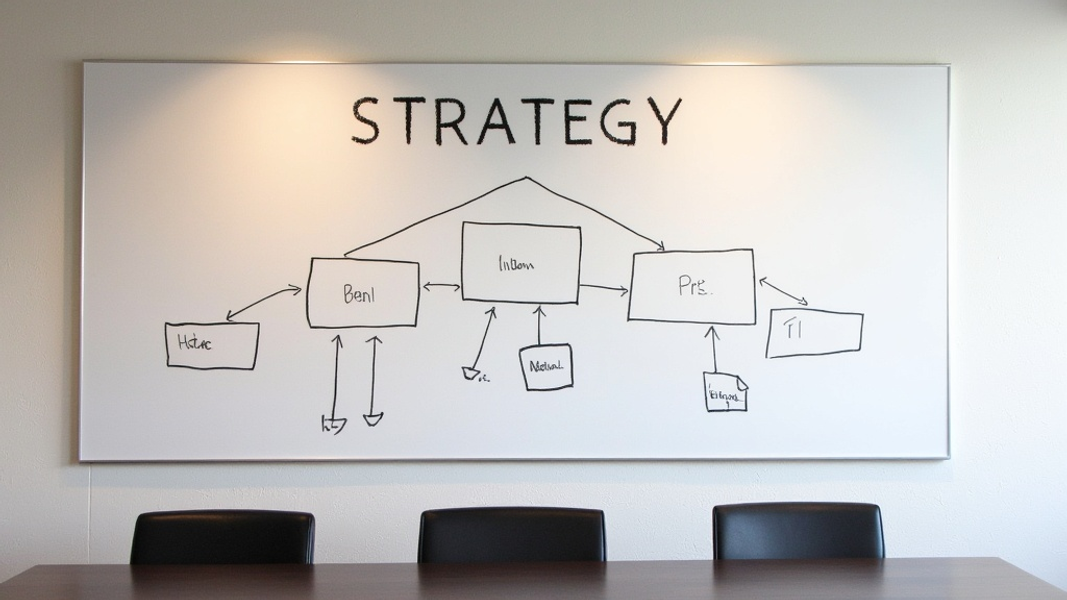
Introduction
Have you ever wondered why some companies soar while others crash and burn? The answer often lies in their business model. This guide will walk you through what a business model is, why it's vital, and how to craft one that sets your company up for success.
What is a Business Model?
Definition and Importance
A business model is the blueprint for how a company creates, delivers, and captures value. It's the core strategy that outlines how a business will make money and thrive in its market. Think of it as the engine that powers your company's success.
Business models are crucial because they force you to think strategically about your company's operations. They help ensure that all your decisions align with your overall business strategy. Whether you're a startup founder, launching a new product, or entering a new market, a solid business model is your roadmap to success.
Key Components
Every effective business model has three main parts: the value proposition, value delivery, and value capture.
The value proposition is all about your customers. Who are they? What problem are you solving for them? How is your solution different from what's already out there? This is where you define why customers should choose you over your competitors.
Value delivery focuses on how you'll get your product or service to your customers. What resources do you need? What key activities must you perform? Who are your important partners? This section outlines the nuts and bolts of your operations.
Value capture is about the money. How will you make revenue? What are your main costs? How will you turn a profit? This part ensures your business is financially viable in the long run.
Business Model vs. Business Plan
Key Differences
While often confused, business models and business plans serve different purposes. A business model is your high-level strategy for creating and capturing value. It's the big picture of how your business will operate and make money.
A business plan, on the other hand, is a detailed roadmap for implementing your business model. It includes specific operational details, financial projections, and timelines.
When to Use Each
Use a business model when you're in the early stages of planning or when you need to pivot your strategy. It's perfect for brainstorming and testing different approaches to your business.
A business plan comes into play when you're seeking investment or need a detailed operational guide. It's the document that turns your business model into actionable steps and concrete goals.
Types of Business Models
Product-Based Models
Product-based models focus on creating and selling physical or digital goods. Examples include:
- Manufacturing: Companies like Apple that design and produce their own products.
- Retail: Businesses like Walmart that buy products from manufacturers and sell them to consumers.
- Subscription: Services like Netflix that charge a recurring fee for access to their products.
Service-Based Models
Service-based models offer skills, expertise, or access to resources. Common types include:
- Fee-for-service: Professionals like lawyers or consultants who charge for their time and expertise.
- Freemium: Platforms like Spotify that offer basic services for free but charge for premium features.
- Software-as-a-Service (SaaS): Companies like Salesforce that provide cloud-based software solutions.
Marketplace Models
Marketplace models connect buyers and sellers. They include:
- Two-sided marketplace: Platforms like Airbnb that facilitate transactions between two groups.
- Advertising-based: Social media platforms like Facebook that offer free services to users and make money from advertisers.
- Affiliate: Websites that earn commissions by promoting other companies' products.
How to Create a Business Model
1. Identify Your Target Market
Start by defining who your customers are. What groups of people will benefit most from your product or service? Understanding your target market is crucial for tailoring your offering and marketing efforts.
Next, dig deep into your customers' needs and pain points. What problems are they facing that your business can solve? The more clearly you can articulate these issues, the better positioned you'll be to address them.
2. Develop Your Value Proposition
Your value proposition is the heart of your business model. It's the unique benefit you offer that sets you apart from competitors. To develop a strong value proposition, focus on how your product or service solves customer problems or improves their situation.
Make sure your value proposition aligns closely with your customers' needs. It should be clear, concise, and compelling. A good value proposition answers the question, "Why should I choose your business over others?"
3. Determine Revenue Streams
How will your business make money? This is where you decide on your pricing strategy and identify potential sources of revenue. Will you charge a one-time fee, use a subscription model, or something else entirely?
Consider multiple revenue streams to diversify your income. For example, a software company might offer both a free basic version and a paid premium version, while also earning money from professional services or partnerships.
4. Outline Key Resources and Activities
What do you need to deliver on your value proposition? List the essential assets, skills, and capabilities your business requires. This might include physical resources like equipment, intellectual property like patents, or human resources like skilled employees.
Next, define the core activities your business must perform to be successful. These are the day-to-day operations that keep your business running and delivering value to customers.
5. Identify Key Partners
Few businesses operate in isolation. Identify the strategic alliances and partnerships that will help your business thrive. These might include suppliers, distributors, or even complementary businesses.
Consider what activities you might outsource or what resources you could access through partnerships. Smart collaborations can help you focus on your core competencies while leveraging others' strengths.
6. Calculate Costs
Understanding your costs is crucial for ensuring your business model is financially viable. Estimate both your fixed costs (expenses that don't change with production volume) and variable costs (expenses that increase or decrease with production).
Use this information to project your break-even point - the point at which your revenue equals your total costs. This will help you understand how much you need to sell to start making a profit.
Analyzing and Improving Your Business Model
Competitive Analysis
To refine your business model, start by studying your successful competitors. What are they doing right? How do they structure their businesses? This analysis can reveal industry best practices and potential areas for improvement in your own model.
Next, look for gaps in the market. Are there customer needs that aren't being met? These gaps represent opportunities for your business to differentiate itself and capture market share.
Testing and Iteration
Don't expect to get your business model perfect on the first try. Start with a minimum viable product (MVP) - the simplest version of your product that can still provide value to customers. This allows you to test your core assumptions with real customers.
Gather feedback from early customers and be ready to adapt. Your initial business model is a hypothesis, and real-world data will help you refine and improve it.

Measuring Success
To know if your business model is working, you need to define key performance indicators (KPIs). These are measurable values that show how effectively your business is achieving its objectives. Common KPIs include customer acquisition cost, customer lifetime value, and churn rate.
Regularly review these KPIs and be prepared to adjust your model based on the data. A successful business model isn't static - it evolves with changing market conditions and customer needs.
Case Studies
Successful Business Model Innovation
Let's look at how Netflix transformed its business model. Netflix started as a DVD rental service, mailing physical discs to customers. As technology evolved, they pivoted to a streaming model, offering unlimited access to digital content for a monthly fee. This shift allowed them to reach a global audience and become a leader in the entertainment industry.
Another example is Apple's ecosystem of products and services. Apple doesn't just sell devices; they've created an interconnected system where each product enhances the value of the others. This model has led to high customer loyalty and consistent revenue streams from both hardware sales and digital services.
Business Model Failures
Not all business models stand the test of time. Blockbuster, once a giant in video rentals, failed to adapt to changing consumer preferences. They stuck to their brick-and-mortar rental model while Netflix innovated with mail-order and then streaming services. Blockbuster's resistance to change led to their eventual bankruptcy.
Similarly, Kodak struggled with the transition to digital photography. Despite inventing the first digital camera, Kodak clung to its film-based business model for too long. By the time they fully embraced digital, competitors had already captured the market.

Conclusion
A well-crafted business model is the foundation of any successful company. It defines how you create value for customers, deliver that value, and capture some of that value as profit. By understanding the components of a business model and how to create and refine one, you're better equipped to build a thriving business.
Remember, your business model isn't set in stone. The most successful companies are those that can adapt their models to changing market conditions, customer needs, and technological advancements. Stay flexible, keep learning from your successes and failures, and don't be afraid to innovate.
Whether you're an entrepreneur just starting out or a business leader looking to pivot your strategy, take the time to develop and refine your business model. It's an investment that will pay dividends in the long run, helping you navigate challenges and seize opportunities in the ever-changing business landscape.
Frequently Asked Questions
How often should I review my business model?
You should review your business model at least once a year. However, in fast-changing industries or during periods of rapid growth, more frequent reviews may be necessary. Always be ready to adapt your model based on market changes, customer feedback, and performance data.
Can a company have multiple business models?
Yes, many large companies operate with multiple business models. For example, Amazon has distinct models for its e-commerce platform, cloud services (AWS), and subscription services (Amazon Prime). Each division may have its own business model that contributes to the overall success of the company.
How do I know if my business model is working?
The effectiveness of your business model is reflected in your key performance indicators (KPIs). If you're meeting or exceeding your targets for metrics like revenue growth, customer acquisition, and profitability, your model is likely working well. However, if you're consistently falling short of these goals, it may be time to reassess and adjust your model.
What's the biggest mistake people make when creating a business model?
One of the biggest mistakes is failing to align the business model with customer needs. A business model that looks great on paper but doesn't solve real customer problems or create genuine value is unlikely to succeed. Always start with a deep understanding of your target market and build your model around meeting their needs.
How detailed should my business model be?
Your business model should be detailed enough to provide a clear roadmap for your business, but not so complex that it becomes difficult to communicate or adapt. Start with a high-level overview that covers all key components, and then drill down into more detail for each area as needed. The level of detail may also depend on the stage of your business and your audience (e.g., investors may require more detail than internal team members).
